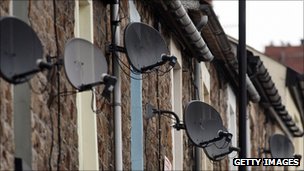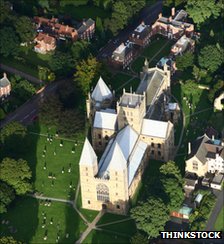From BBC News:
https://www.bbc.co.uk/news/magazine-15125287
Probably more relevant when backpacking through Europe, but interesting nonetheless
1. TV satellite dishes

Look for satellite dishes and signs of weathering
These really are the "get out of jail free" cards in an urban area.
This is because the dishes point at a geostationary satellite, one that stays over the same point on the Earth's surface.
In the UK there is a dominant satellite broadcaster, hence nearly all the dishes tend to point in the same direction - close to southeast.
The same applies in rural areas - especially those blessed with pubs screening sport.
2. Religious buildings

From earliest times, religious buildings and sacred sites have been laid out to give clues as to direction.
Christian churches are normally aligned west-east, with the main altar at the eastern end to face the sunrise. Gravestones, too, are aligned west-east.
To find direction from a mosque, you need to go inside and look for the niche in one wall, which indicates the direction for prayer. This niche, known as al-Qibla, will be the direction of Mecca, wherever you are in the world.
And synagogues normally place the Torah Ark at the eastern end, positioned so worshippers face towards Jerusalem. (Synagogues in countries east of Israel will face west.)
3. Weathering
The prevailing winds carry rain and pollution. These then hit the buildings, leaving patterns.
The wind comes from the southwest in the UK more often than from any other direction. This results in asymmetrical weathering patterns on buildings - similar to the erosion seen in nature.
Look up, above the cleaned glass and metals of the lower floors, to the natural stone or weathered bricks higher up.
Notice how the building's corners all show subtly different weathering patterns.
The contrast between southwest and northeast corners is the greatest. But the shifts in colours, where the rain and pollutants have left their mark, can be read on all sides with a little practice.
Trees, too, indicate direction, with the very tops combed over by the prevailing wind.
4. Flow of people
Rush hour crowds point the way
Pacific navigators learned to follow the birds in their search of land. They quickly realised that while an individual bird can behave eccentrically, a pair - or even better a flock - will follow a pattern.
The same is true of human beings. There is no point following an individual, you could end up anywhere. But following a crowd in the late afternoon will take you towards a station or other transport hub. In the mornings, walk against the flow to find these stations.
At lunchtime in sunny weather, crowds move from office blocks towards the open spaces of parks and rivers.
5. Road alignment
Wind direction and road layout can help
Roads do not spring up randomly, they grow to carry traffic - and the bulk of traffic is either heading into or out of a town. So the biggest roads tend to be aligned in a certain way, depending on whether you are in the centre or on the outskirts.
In the north or south of town, the major roads will tend to be aligned north/south. In the northwest or southeast, they will have a bias towards northwest/southeast. This is why road maps of big towns show a radial pattern.
It is common sense, but very few people realise this when they feel lost in a big city.
6. Clouds
One of the best ways not to lose your sense of direction is to hold onto it. My favourite way of doing this in a city is to orientate myself - using some of the clues above - and then note the direction the clouds are moving.
The wind pushing the clouds will remain fairly constant, providing there's no dramatic change in the weather.
This technique really earns its keep on underground journeys, especially to a new part of town. Simply look up before you head underground, and remember the direction of the clouds. When you emerge in a strange part of the city, look up again and you'll be able to work out which way is which from the clouds overhead.
https://www.bbc.co.uk/news/magazine-15125287
Probably more relevant when backpacking through Europe, but interesting nonetheless
1. TV satellite dishes

Look for satellite dishes and signs of weathering
These really are the "get out of jail free" cards in an urban area.
This is because the dishes point at a geostationary satellite, one that stays over the same point on the Earth's surface.
In the UK there is a dominant satellite broadcaster, hence nearly all the dishes tend to point in the same direction - close to southeast.
The same applies in rural areas - especially those blessed with pubs screening sport.
2. Religious buildings

From earliest times, religious buildings and sacred sites have been laid out to give clues as to direction.
Christian churches are normally aligned west-east, with the main altar at the eastern end to face the sunrise. Gravestones, too, are aligned west-east.
To find direction from a mosque, you need to go inside and look for the niche in one wall, which indicates the direction for prayer. This niche, known as al-Qibla, will be the direction of Mecca, wherever you are in the world.
And synagogues normally place the Torah Ark at the eastern end, positioned so worshippers face towards Jerusalem. (Synagogues in countries east of Israel will face west.)
3. Weathering
The prevailing winds carry rain and pollution. These then hit the buildings, leaving patterns.
The wind comes from the southwest in the UK more often than from any other direction. This results in asymmetrical weathering patterns on buildings - similar to the erosion seen in nature.
Look up, above the cleaned glass and metals of the lower floors, to the natural stone or weathered bricks higher up.
Notice how the building's corners all show subtly different weathering patterns.
The contrast between southwest and northeast corners is the greatest. But the shifts in colours, where the rain and pollutants have left their mark, can be read on all sides with a little practice.
Trees, too, indicate direction, with the very tops combed over by the prevailing wind.
4. Flow of people
Rush hour crowds point the way
Pacific navigators learned to follow the birds in their search of land. They quickly realised that while an individual bird can behave eccentrically, a pair - or even better a flock - will follow a pattern.
The same is true of human beings. There is no point following an individual, you could end up anywhere. But following a crowd in the late afternoon will take you towards a station or other transport hub. In the mornings, walk against the flow to find these stations.
At lunchtime in sunny weather, crowds move from office blocks towards the open spaces of parks and rivers.
5. Road alignment
Wind direction and road layout can help
Roads do not spring up randomly, they grow to carry traffic - and the bulk of traffic is either heading into or out of a town. So the biggest roads tend to be aligned in a certain way, depending on whether you are in the centre or on the outskirts.
In the north or south of town, the major roads will tend to be aligned north/south. In the northwest or southeast, they will have a bias towards northwest/southeast. This is why road maps of big towns show a radial pattern.
It is common sense, but very few people realise this when they feel lost in a big city.
6. Clouds
One of the best ways not to lose your sense of direction is to hold onto it. My favourite way of doing this in a city is to orientate myself - using some of the clues above - and then note the direction the clouds are moving.
The wind pushing the clouds will remain fairly constant, providing there's no dramatic change in the weather.
This technique really earns its keep on underground journeys, especially to a new part of town. Simply look up before you head underground, and remember the direction of the clouds. When you emerge in a strange part of the city, look up again and you'll be able to work out which way is which from the clouds overhead.




